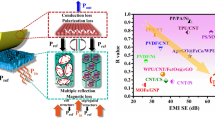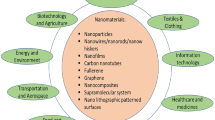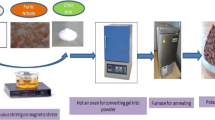Abstract
Core–shell iron nanoparticles have been synthesized by pyrolysis of nanocomposite of oxides of iron–tin (Fe–Sn). The core–shell nanoparticles of phase pure iron in carbonaceous shell are formed only at very low concentration of tin (0.0011 mol) in the nanocomposite sample. From different studies viz. X-ray diffraction, high-resolution transmission electron microscopy, atomic force microscopy, and Raman spectroscopy, it has been established that core–shell nanostructures have been formed with Fe as core and amorphous carbon as the shell. The heating of nanocomposite at different temperatures up to 900 °C revealed very interesting dynamics of formation of core–shell structure wherein above 650 °C the iron carbide phase decomposes and carbon atoms move out to form an amorphous shell around iron nanoparticles. This process of formation of core–shell structures is quite different from conventional way wherein synthesis of core material precedes formation of shell in two different steps. The microwave absorption properties of core–shell nanoparticles have been studied by making their composites in nitrile butadiene rubber. Reflection loss simulation studies show high values in the X and Ku bands of microwave region. The frequency of maximum return loss can be tuned through variation of composition and thickness of composite layer.










Similar content being viewed by others
References
Arruebo M, Galan M, Navascues N, Tellez C, Marquina C, Ibarra MR, Santamaria J (2006) Development of magnetic nanostructured silica-based materials as potential vectors for drug-delivery applications. Chem Mater 18(7):1911–1919
Cook PS, Cashion JD (1988) Interactions of iron and tin-based promoters during brown coal liquefaction. Fuel 67:1428–1435
Ferrari AC, Robertson J (2000) Interpretation of Raman spectra of disordered and amorphous carbon. Phys Rev B 61(20):14095–14107
Han Z, Li D, Wang H, Liu XG, Li J, Geng DY, Zhang ZD (2009) Broadband electromagnetic-wave absorption by FeCo/C nanocapsules. Appl Phys Lett 95:023114
Hayashi T, Hirono S, Tomita M, Umemura S (1996) Magnetic thin films of cobalt nanocrystals encapsulated in graphite-like carbon. Nature 381:772–774
Hernadi K, Fonseca A, Nagy JB, Fudala A, Bernaerts D, Kiricsi I (2002) Catalytic production of carbon nanofibers over iron carbide doped with Sn+2. Appl Catal A 228:103–113
Hou H, Schaper AK, Weller F, Greiner A (2002) Carbon nanotubes and spheres produced by modified ferrocene pyrolysis. Chem Mater 14(9):3990–3994
Kluson P, Cerveny L (1997) Ru–Sn catalyst—A new promising system for selective hydrogenation of a carbonyl group. Chem Listy 91:100–104
Lastella S, Jung YJ, Yang H, Vajtai R, Ajayan PM, Ryu CY, Rider DA, Manners I (2004) Density control of single-walled carbon nanotubes using patterned iron nanoparticles catalysts derived from phase-separated thin films of a polyferrocene block copolymer. J Mater Chem 14:1791–1794
Li R, Sun X, Zhou X, Cai M, Sun X (2007) Aligned heterostructures of single-crystalline tin nanowires encapsulated in amorphous carbon nanotubes. J Phys Chem C 111:9130–9135
Lian LX, Deng LJ, Han M, Tang W, Feng SD (2007) Microwave electromagnetic and absorption properties of Nd2Fe14B/α-Fe nanocomposites in the 0.5–18 and 26.5–40 GHz ranges. J Appl Phys 101:09M5201-09M5203
Liu JR, Itoh M, Machida K (2003) Electromagnetic wave absorption properties of α-Fe/Fe3B/Y2O3 nanocomposites in gigahertz range. Appl Phys Lett 83:4017
Liu JR, Itoh M, Horikawa T, Itakura M, Kuwano N, Machida K (2004) Complex permittivity, permeability and electromagnetic wave absorption of α-Fe/C(amorphous) and Fe2B/C(amorphous) nanocomposites. J Phys D 37:2737–2741
Lu Y, Zhu Z, Liu Z (2005) Carbon-encapsulated Fe nanoparticles from detonation-induced pyrolysis of ferrocene. Carbon 43:369–374
Lu B, Dong XL, Huang H, Zhang XF, Zhu XG, Lei JP, Sun JP (2008) Microwave absorption properties of the core/shell-type iron and nickel nanoparticles. J Magn Magn Mater 320:1106–1111
Michielssen E, Sajer J, Ranjithan S, Mittra R (1993) Design of lightweight, broad-band microwave absorbers using genetic algorithms. IEEE Trans Microwave Theory Tech 41(6):1024–1031
Ni X, Zheng Z, Xiao X, Huang L, He L (2010) Silica-coated iron nanoparticles: shape-controlled synthesis, magnetism and microwave absorption properties. Mater Chem Phys 120:206–212
Pol VG, Motiei M, Gedanken A, Calderon-Moreno J, Mastai Y (2003) Sonochemical deposition of air-stable iron nanoparticles on monodispersed carbon spherules. Chem Mater 15:1378–1384
Ponder SM et al (2001) Surface chemistry and electrochemistry of supported zerovalent iron nanoparticles in the remediation of aqueous metal contaminants. Chem Mater 13(2):479–486
Ravindran R, Gangopadhyay K, Gangopadhyay S, Mehta N, Biswas N (2006) Permittivity enhancement of aluminum oxide thin films with the addition of silver nanoparticles. Appl Phys Lett 89:263511–263513
Ross CA (2001) Patterned magnetic recording media. Annu Rev Mater Res 31:203–235
Saito Y (1995) Nanoparticles and filled nanocapsules. Carbon 33(7):979–988
Sano N, Akazawa H, Kikuchi T, Kanki T (2003) Separated synthesis of iron-included carbon nanocapsules and nanotubes by pyrolysis of ferrocene in pure hydrogen. Carbon 41(11):2159–2162
Srinivasan R, Davis BH (1992) The structure of platinum–tin reforming catalysts. Platin Met Rev 36(3):151–163
Sun XC, Nava N (2002) Microstructure and magnetic properties of Fe(C) and Fe(O) nanoparticles. Nano Lett 2:765–769
Vadera SR, Mathur R, Parihar M, Kumar N (1997) Direct synthesis of nanocomposite of γ-Fe2O3 in the copolymer matrix of aniline–formaldehyde in presence of zinc ions. Nanostruct Mater 8:889–898
Wang ZH, Choi CJ, Kim BK, Kim JC, Zhang ZD (2003) Characterization and magnetic properties of carbon-coated cobalt nanocapsules synthesized by the chemical vapor-condensation process. Carbon 41(9):1751–1758
Yuliang AN, Xia Y, Shinan C, Chang L (2006) Preparation of carbon nanocapsules coating metal based on cellulose. Nanoscience 11:179–182
Zhang XF, Dong XL, Huang H, Lv B, Lei JP, Choi CJ (2007) Microstructure and microwave absorption properties of carbon coated iron nanocapsules. J Phys D 40:5383–5387
Acknowledgments
The authors are thankful to Prof. O. N. Srivastava, Banaras Hindu University, Varanasi for carrying out HRTEM studies of our samples and Amit Sadh, Defence Laboratory, Jodhpur for carrying out Raman studies for our samples.
Author information
Authors and Affiliations
Corresponding author
Electronic supplementary material
Below is the link to the electronic supplementary material.
Rights and permissions
About this article
Cite this article
Gupta, V., Patra, M.K., Shukla, A. et al. Synthesis of core–shell iron nanoparticles from decomposition of Fe–Sn nanocomposite and studies on their microwave absorption properties. J Nanopart Res 14, 1271 (2012). https://doi.org/10.1007/s11051-012-1271-0
Received:
Accepted:
Published:
DOI: https://doi.org/10.1007/s11051-012-1271-0




